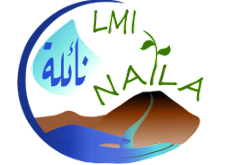Aquifer balance sheet
This action aims to study the impact of hydro-agricultural developments on the evolution of superficial aquifers.
The aim is to document and model the recharge produced by leaks from the Lebna dam (Cap Bon) to anticipate its evolution under the influence of variations in the water supply of the dam.
For this, we implement a combined approach: establishment of the surface water balance, establishment of the evaporation balance of the lake, characterization of the materials of the banks and the bottom, and hydrogeological modeling of the leak.
In this context, we use the synergy between hydro-climatic, geochemical and geophysical measurements. The analysis of the daily hydrological balance over 27 years highlights a leakage term depending on the height of water in the dam during periods of non-supply (decrease > evaporation). Integrated over periods of 10 days, the intensity of the leak shows an increasing relationship between the elevations 16 m and 18 m (spill at 18.04 m). The estimated annual recharge volume is 3.8,106 m3.year-1, without being able to give a precision given the strong uncertainties on evaporation and discrete supplies.
Geological and geophysical surveys indicate the presence of permeable materials represented by Quaternary and Pliocene sandy facies which outcrop on the south shore of the lake at coasts consistent with bank leakage [16-18 m]. 68 vertical electrical soundings and 13 electric tomography panels are being interpreted to estimate the extension of the geological facies suitable for driving the recharge flow towards the coastal aquifer. The isotopic monitoring in progress will make it possible to refine the evaporation balance. This action is based on new collaborations (CERTE, G-EAU, LISAH), it mobilizes skills in hydro-climatology, geochemistry and geophysics (axis 1 and 2 of the LMI), and it includes a thesis supervision (FST Tunis).
In the medium term, methodological developments will make it possible to characterize the modulation of the recharge according to agro climatic scenarios on the Lebna watershed (axis 3), and the results obtained will enlighten decision-makers on the impact of development policies.
Actions in detail
Hydrological, isotopic and hydrogeological quantification of the concentrated recharge caused by the Lebna dam: modeling of dam-aquifer interactions supported by geophysics
Thesis (axes 1, 2 and 3 of the LMI): Nejmeddine OUHICHI (CERTE/LISAH/G-EAU)
Thesis supervisor: Hakim Ghabtni (CERTE/LG)
Supervisors: Fethi LACHAAL (CERTE/LG), Olivier GRÜNBERGER (IRD/LISAH), Radhouane Hamdi (IRD/LISAH), Christian LEDUC (IRD/G-EAU), Sylvain MASSUEL (IRD/G-EAU)
| Goals | The thesis aims to document and model the recharge term of the Lebna dam lake (Cap Bon) in order to anticipate its evolution according to variations in the water supply of the dam. This recharge is indeed difficult to evaluate by the hydrological balance of the lake of the reservoir because a negative term of surface balance can result from the combination of a leak and a simultaneous supply. Estimating the recharge and modeling its dynamics therefore require a combined approach: establishment of the surface water balance, characterization of the bank and bottom materials, the evaporation balance of the lake by geochemical tracers, hydrogeological modeling of the leak. |
| Approach/methodology | A first analysis of the daily hydrological balance over 27 years highlights a leakage term depending on the height of water in the dam during the supposed periods of non-supply (fall > evaporation). Integrated over periods of 10 days, the intensity of the leak shows an increasing relationship between the 16 m and 18 m elevations (18.04 m being the spill elevation). The average annual volume of recharge estimated is 3.8 106m3/year, without it being possible for the moment to give a precision to this term in view of the strong uncertainties on evaporation and discrete supplies. The geological and geophysical study highlights the presence of permeable materials represented by sandy facies of the Quaternary and Pliocene which outcrop on the south shore of the lake at coasts consistent with the phenomenon of bank leakage [16-18m]. 68 vertical electrical soundings (SEV) and 13 panels of electric homographies are being interpreted to give an estimate of the extension of the geological facies suitable for conducting the recharge flow towards the coastal aquifer. The isotopic monitoring also in progress will make it possible to refine the evaporation balance. |
